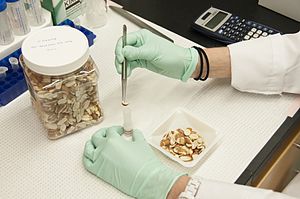
Fireless cookers and slow cookers[edit | edit source]
It is usually important that food is brought to a boil for an adequate time, particularly for foods such as meats or beans. This will help to kill any pathogens, so they will not grow back too quickly when the temperature drops. With legumes (especially kidney beans and chickpeas), food poisoning is possible if they are not cooked at a high enough temperature - but with pre-soaking and then boiling for 20-25 minutes, this should not be a problem.
Simply warming or partially reheating food, then keeping it warm in the fireless cooker, is potentially dangerous, especially if the food is left for a long time, as the warm temperature will allow pathogens to grow more quickly.
Food safety (or food hygiene) is used as a scientific method/discipline describing handling, preparation, and storage of food in ways that prevent foodborne illness. The occurrence of two or more cases of a similar illness resulting from the ingestion of a common food is known as a food-borne disease outbreak. This includes a number of routines that should be followed to avoid potential health hazards. In this way, food safety often overlaps with food defense to prevent harm to consumers. The tracks within this line of thought are safety between industry and the market and then between the market and the consumer. In considering industry-to-market practices, food safety considerations include the origins of food including the practices relating to food labeling, food hygiene, food additives and pesticide residues, as well as policies on biotechnology and food and guidelines for the management of governmental import and export inspection and certification systems for foods. In considering market-to-consumer practices, the usual thought is that food ought to be safe in the market and the concern is safe delivery and preparation of the food for the consumer. Food safety, nutrition and food security are closely related. Unhealthy food creates a cycle of disease and malnutrition that affects infants and adults as well.
Food can transmit pathogens, which can result in the illness or death of the person or other animals. The main types of pathogens are bacteria, viruses, parasites, and fungus. The WHO Foodborne Disease Epidemiology Reference Group conducted the only study that solely and comprehensively focused on the global health burden of foodborne diseases. This study, which involved the work of over 60 experts for a decade, is the most comprehensive guide to the health burden of foodborne diseases. The first part of the study revealed that 31 foodborne hazards considered priority accounted for roughly 420,000 deaths in LMIC and posed a burden of about 33 million disability adjusted life years in 2010. Food can also serve as a growth and reproductive medium for pathogens. In developed countries there are intricate standards for food preparation, whereas in lesser developed countries there are fewer standards and less enforcement of those standards. Even so, in the US, in 1999, 5,000 deaths per year were related to foodborne pathogens. Another main issue is simply the availability of adequate safe water, which is usually a critical item in the spreading of diseases. In theory, food poisoning is 100% preventable. However this cannot be achieved due to the number of persons involved in the supply chain, as well as the fact that pathogens can be introduced into foods no matter how many precautions are taken.
Beans[edit | edit source]
With legumes, especially kidney beans and chickpeas (garbanzos), food poisoning is possible if they are not cooked properly.
With pre-soaking and then boiling for 20-25 minutes, this problem is avoided - the beans can then be placed in a fireless cooker. See Cooking beans for more.
Notes[edit | edit source]